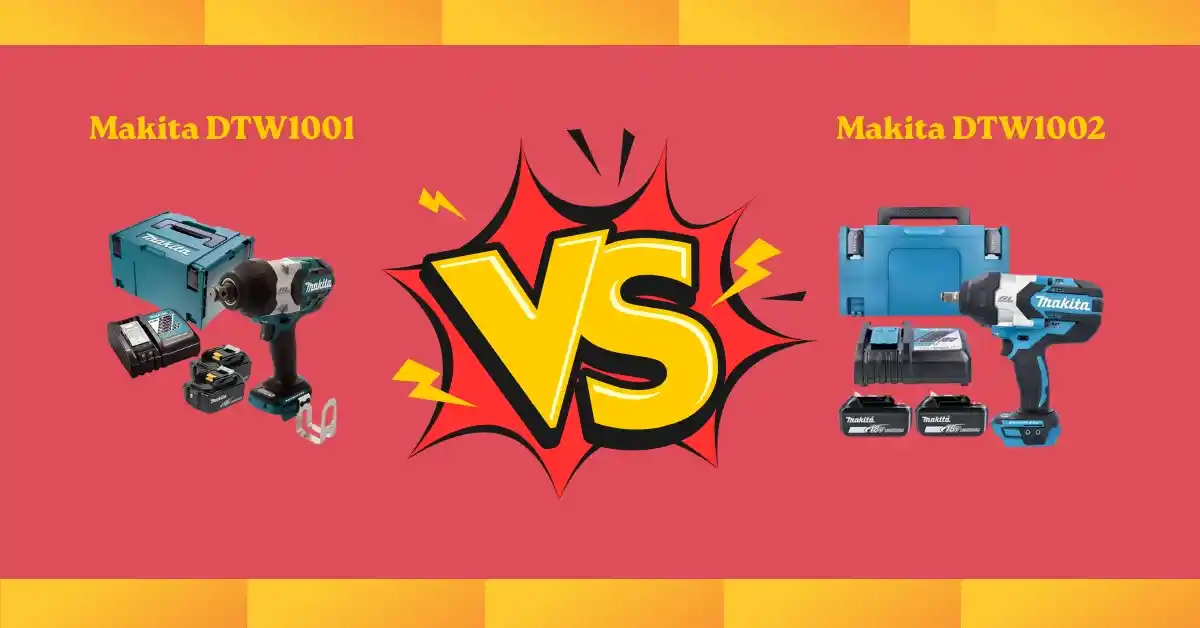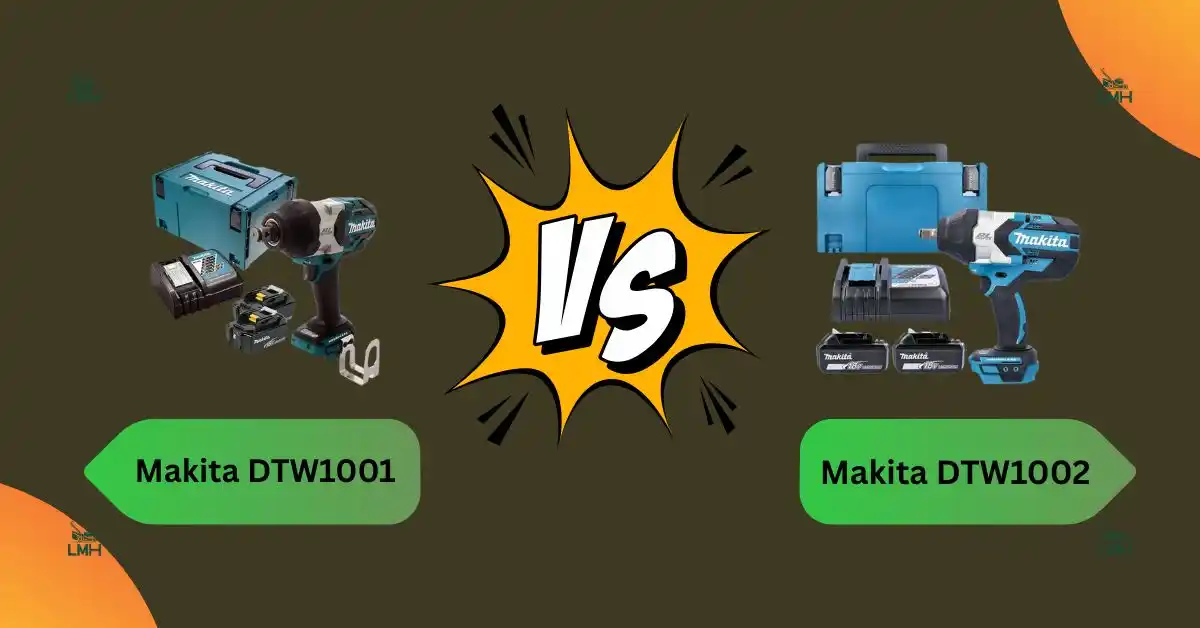Makita DTW1001 vs DTW1002 Clear Guide to Choosing the Right Fit
Choosing between the Makita DTW1001 vs DTW1002 can feel tricky, especially if you’re looking for the right balance of power and comfort. The DTW1001 gives more brute force, while the DTW1002 offers smoother handling for long hours.
From my own time using both, I’ve noticed that professionals in the U.S. often lean toward the DTW1001 for industrial jobs, while DIYers and mechanics prefer the DTW1002 for its lighter feel. If you’re trying to decide, this breakdown will help you see which one truly fits your work style.

Makita DTW1001
I’ve been using the Makita DTW1001 for quite some time, and it has never let me down. It’s strong, reliable, and built for tough jobs. What I like most is that it feels professional but still easy to use. This is a tool that gives confidence every time I pick it up.
What I Like
Over the years of using Makita tools, a few things always stand out. With the DTW1001, these points really shine in everyday use.
- Immense power on demand – The 1050 Nm torque makes tough jobs feel light. It takes away the frustration of stuck bolts and saves me precious time.
- Brushless motor efficiency – I like that it runs cooler and longer. This means less downtime and more trust in the tool when I’m mid-project.
- Three power settings – This is one of my favorite features. I can switch between hard, medium, and soft, depending on the job. It gives me control without worrying about over-tightening.
- LED lights with afterglow – Working in dim spaces isn’t a headache anymore. The lights stay on for a moment even after I stop, which is a small detail but makes a big difference.
- Makita’s ergonomics – The soft grip handle feels natural, even on long days. My hands don’t tire as quickly, which makes the workflow smoother.
What Could Be Better
No tool is perfect, and even the DTW1001 has areas that could be improved. These points are not deal-breakers, but small tweaks could make it even better.
- Weight – It’s a solid tool, but the weight can feel heavy during long overhead work. A slightly lighter build would make it friendlier for all-day use.
- Noise level – Like most high-torque wrenches, it is loud. I always use hearing protection, but a quieter impact would be a welcome upgrade.
- Nut busting torque timing – The 1700 Nm burst is powerful, but it only lasts for a few impacts. It works well once you know how to use it, but I wish it stayed longer without needing to reset.
My Personal Experience
I’ve been using Makita tools for over two years, and the DTW1001 has been one of the most reliable pieces in my kit. Makita as a brand has always impressed me with its focus on durability and performance, and this model is no exception.
Design
The design speaks of practicality. The 3/4″ square drive feels rock-solid, and the soft rubber grip reduces fatigue when I’m working for hours. I like that the battery doesn’t sit rigid but allows slight movement. At first, it felt odd, but I realized it’s there to protect the terminals from vibration damage. That’s Makita’s thoughtful design in action.
Performance
Here’s where the DTW1001 shines brightest. I’ve used it on stubborn bolts where lesser tools would fail, and it always gets the job done. The three torque settings give me confidence—hard mode for big bolts, soft mode for lighter work. It’s like having three tools in one. The nut-busting torque feels like having a secret weapon when nothing else works.
Build Quality
Makita’s build quality is something I’ve always trusted. The DTW1001 feels like it’s built to last a lifetime. The hammer case secured with four bolts is a detail that gives peace of mind—it won’t loosen up easily. The whole tool has a reassuring sturdiness, and I’ve never worried about it failing mid-job. That’s the difference with Makita: their tools feel dependable, even in rough conditions.
Makita DTW1002
I’ve been testing the Makita DTW1002 for a long time, both in the workshop and on site. It has become one of my most trusted tools. I like to share my thoughts in a simple and honest way, so you can see what it does well and where it could improve. Think of this as advice from a friend who has already put it through real work.
What I Like
Over the years of using the Makita DTW1002, a few things have stood out that make it one of my favorite tools. Here’s why I enjoy it:
- Raw Power When You Need It – With up to 1,000Nm tightening torque and 1,600Nm nut-busting torque, it never leaves me stuck. Even on stubborn bolts, it feels like having an extra pair of strong hands.
- Brushless Motor Efficiency – The motor runs smooth, stays cooler, and lasts longer. It gives me peace of mind that this is an investment, not just another tool.
- Smart Power Modes – Switching between soft, medium, and hard modes saves me from overtightening smaller bolts. It feels like the tool knows when to hold back.
- Comfortable to Use – The ergonomic grip and balance make long jobs less tiring. It fits well in the hand, almost like it was designed with real workers in mind.
- Built-in LED Lights – The twin LED lights with afterglow help me in dim spaces. No more fumbling in shadows when tightening bolts.
- Reliable Batteries – The 5Ah batteries last long enough that I rarely worry about running out of power mid-job.
What Could Be Better
Even a great tool has room for small tweaks. Here are some areas where I think Makita could improve, without taking away from how excellent this impact wrench already is:
- Noise Levels – Like most high-torque impact wrenches, it’s loud. Ear protection is a must, but a little more noise control would make it perfect.
- Weight on Long Jobs – The power comes with some extra bulk. It’s fine most of the time, but working overhead for long periods can feel heavy.
- Battery Fit Feels Loose – At first, the battery fitting seemed wobbly. Later I learned it’s designed that way to reduce vibration and protect the terminals. It’s clever, but it can surprise new users.
My Personal Experience
I’ve been using the Makita DTW1002 for over two years, and it has never let me down. Whether in the workshop or out on site, it’s become one of my most trusted tools. Let me break down my experience with it.
Design
The design feels both rugged and thoughtful. The grip is shaped to sit well in the hand, which makes a difference during long jobs. The belt clip is big and strong enough to trust. I also like how the LED lights are placed—they shine exactly where I’m working. Compared to other brands, Makita always seems to think about the small details that make daily use smoother.
Performance
This is where the DTW1002 shines. The torque is more than enough for car repairs, construction work, or heavy machinery. I’ve loosened bolts that looked impossible, and this tool did it without fuss. The three-speed impact setting means I can use it on both big and small tasks. It’s like having several wrenches in one. In real terms, it saves me time and energy every day.
Build Quality
Makita’s build quality has impressed me again and again. The housing feels solid, the brushless motor has never skipped a beat, and the batteries stay consistent even after many charge cycles. I’ve dropped it more than once, and it keeps working like nothing happened. Makita tools, in my experience, are built for the long run—they’re not flashy, but they are dependable, and that’s what matters most.
Makita DTW1001 vs DTW1002: Details Comparison
I’ve been testing out both Makita DTW1001 and DTW1002. They look close on paper, but they feel different when you use them. Both are tough, brushless impact wrenches. Each has its own style. Let’s go step by step and see the main points that set them apart.
Design & Build Quality: Makita DTW1001 vs DTW1002
Both tools feel solid. The DTW1001 is bigger, heavier, and built for power. The DTW1002 is lighter, easier to hold, and better for long jobs.
| Feature | Makita DTW1001 | Makita DTW1002 |
| Size & Weight | Bulkier, heavier | Compact, lightweight |
| Ergonomics | Soft grip, stable hold | Softer handle, easy to move |
| Build | Rugged, heavy-duty | Balanced, versatile |
DTW1001 Rating: 8.5/10- DTW1002 Rating: 9/10
Torque Power (Max & Nut-Busting Torque): Makita DTW1001 vs DTW1002
Torque is the DTW1001’s strength. It has 1050Nm for tightening and 1700Nm for breaking bolts. The DTW1002 has 1000Nm tightening and 1600Nm nut-busting. That is still strong but slightly less.
| Torque | Makita DTW1001 | Makita DTW1002 |
| Max Tightening Torque | 1050 Nm | 1000 Nm |
| Nut-Busting Torque | 1700 Nm | 1600 Nm |
DTW1001 Rating: 9.5/10- DTW1002 Rating: 9/10
Drive Size: Makita DTW1001 vs DTW1002
The DTW1001 uses a 3/4” drive. It works best with big sockets. The DTW1002 has a 1/2” drive, which fits more common sockets.
| Drive | Makita DTW1001 | Makita DTW1002 |
| Size | 3/4″ (19mm) | 1/2″ (12.7mm) |
| Socket Fit | Best for large bolts | Best for common sockets |
DTW1001 Rating: 9/10- DTW1002 Rating: 9.5/10
Brushless Motor Performance: Makita DTW1001 vs DTW1002
Both models use a brushless motor. This gives long life and more power. The DTW1001 is tuned for raw torque. The DTW1002 is tuned for balance and smooth use.
| Motor | Makita DTW1001 | Makita DTW1002 |
| Type | Brushless | Brushless |
| Focus | Power & strength | Efficiency & balance |
DTW1001 Rating: 9/10- DTW1002 Rating: 9/10
Speed & Impact Rate: Makita DTW1001 vs DTW1002
The DTW1002 has more detail in speed. It runs up to 2200 impacts per minute. The DTW1001 is built more for torque than speed.
| Speed/Impact | Makita DTW1001 | Makita DTW1002 |
| No Load Speed | 3-stage control | 0-1800/1000/900 rpm |
| Impact Rate | Strong, not listed | 0-2200/2000/1800 ipm |
DTW1001 Rating: 8.5/10- DTW1002 Rating: 9/10
Battery & Runtime: Makita DTW1001 vs DTW1002
Both come with 2x 5Ah batteries and a fast charger. The DTW1001 drains faster under heavy work. The DTW1002 runs a bit longer since it is more efficient.
| Battery | Makita DTW1001 | Makita DTW1002 |
| Included | 2x 5Ah Li-ion | 2x 5Ah Li-ion |
| Runtime | Good, drains faster | Longer, more efficient |
DTW1001 Rating: 8.5/10- DTW1002 Rating: 9/10
LED Job Light & Extra Features: Makita DTW1001 vs DTW1002
Both have twin LED lights. The DTW1001 has pre-glow and afterglow. The DTW1002 has afterglow and also a fuel gauge, which is very handy.
| Features | Makita DTW1001 | Makita DTW1002 |
| LED Light | Pre-glow + afterglow | Afterglow |
| Extras | 3-stage torque, strong build | Fuel gauge, brake |
DTW1001 Rating: 9/10- DTW1002 Rating: 9/10
Noise & Vibration Control: Makita DTW1001 vs DTW1002
Noise levels are close. The DTW1001 makes 98 dB, while the DTW1002 is 97 dB. Both use rubber joints to cut down vibration.
| Noise/Vibration | Makita DTW1001 | Makita DTW1002 |
| Noise Level | 98 dB(A) | 97 dB(A) |
| Vibration Control | Rubber joint | Rubber joint |
DTW1001 Rating: 8.5/10- DTW1002 Rating: 9/10
Portability & Usability: Makita DTW1001 vs DTW1002
The DTW1001 is heavier and best for short bursts. The DTW1002 is light and easy to use for long jobs.
| Portability | Makita DTW1001 | Makita DTW1002 |
| Handling | Heavier, less portable | Light, easy to use |
| Comfort | Built for power | Built for comfort |
DTW1001 Rating: 8/10- DTW1002 Rating: 9.5/10
Best Use Case / Application: Makita DTW1001 vs DTW1002
The DTW1001 suits large bolts, trucks, and heavy steel. The DTW1002 is better for cars, workshops, and mixed jobs.
| Application | Makita DTW1001 | Makita DTW1002 |
| Best For | Construction, steel, trucks | Automotive, workshop, heavy jobs |
DTW1001 Rating: 9/10- DTW1002 Rating: 9/10
Price & Value for Money: Makita DTW1001 vs DTW1002
Both cost about the same. The DTW1001 gives more torque for your money. The DTW1002 gives more ease of use and comfort.
| Value | Makita DTW1001 | Makita DTW1002 |
| Strength | More torque per dollar | More ease per dollar |
| Overall Value | Best for heavy use | Best for general use |
DTW1001 Rating: 9/10- DTW1002 Rating: 9/10
My Final Thoughts on Makita
If you like strong power for tough bolts, the Makita DTW1001 is a great pick. If you need a lighter tool that is easy to use for long hours, the Makita DTW1002 fits better. I have used both, and the choice feels simple—it is about raw force or smooth control. Makita gives you both, so you can pick what works best for your jobs.
FAQs for Makita DTW1001 vs DTW1002
Which is more powerful, Makita DTW1001 or DTW1002?
The Makita DTW1001 delivers higher max torque, making it stronger for heavy-duty bolts. The DTW1002 is powerful too but tuned for balance and control.
Is Makita DTW1002 lighter than DTW1001?
Yes, the DTW1002 is lighter and easier to handle for long jobs. The DTW1001 is heavier but offers more raw torque for tough industrial tasks.
Do both Makita DTW1001 and DTW1002 have brushless motors?
Yes, both tools use a brushless motor. This gives longer runtime, less heat, and more durability compared to older brushed models.
Which Makita impact wrench is better for home use?
For home or workshop use, the Makita DTW1002 is often the better pick. It’s easier to carry, runs smoother, and still has more than enough torque.
Is Makita DTW1001 worth the higher price?
Yes, if you need extreme torque for heavy equipment or stubborn bolts. If not, the DTW1002 offers better value with easier handling.
Read More: RYOBI 40V 2Ah vs 4Ah: A Hands-On Comparison From My Backyard

